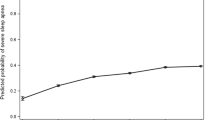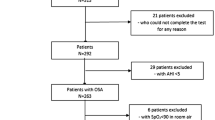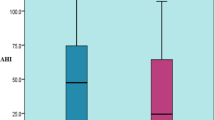Abstract
Information on obstructive sleep apnea–hypopnea syndrome (OSAHS) in Japan has been limited. The purposes of this clinical study were to evaluate the demographic characteristics of Japanese OSAHS patients and to assess how demographic factors are associated with OSAHS severity. We analyzed 3,659 OSAHS patients who underwent polysomnographic evaluation between January 2000 and December 2004 at 11 hospitals in Niigata Prefecture, Japan. Data consisted of apnea–hypopnea index (AHI) and demographic characteristics, including sex, age, and body-mass index, for statistical analysis. Levels of obesity were classified according to the WHO criteria. The male-to-female patient ratio for OSAHS was 4.6, and male patients presented more severe OSAHS than female patients. High AHI and a high proportion of moderate to serious OSAHS (AHI ≥ 15) were found among the patients in their 30s, as well as female patients in their 70s and male patients in their 80s. The AHI and the proportion of moderate-to-serious OSAHS (AHI ≥ 15) were greater in patients classified as underweight than in normal weight patients. In conclusion, there is a higher male predominance in the prevalence of OSAHS, and in both sexes, the results suggest different pathophysiological mechanisms of deteriorating OSAHS between adults under age 55 and adults 55 years or over. In addition, underweight patients exhibit more severe OSAHS than normal weight patients.




Similar content being viewed by others
References
Nieto FJ, Young TB, Lind BK, Shahar E, Samet JM, Redline S, D’Agostino RB, Newman AB, Lebowitz MD, Pickering TG (2000) Association of sleep-disordered breathing, sleep apnea, and hypertension in a large community-based study. JAMA 283:1829–1836
Young T, Peppard PE, Gottleib DJ (2002) Epidemiology of obstructive sleep apnea: a population health perspective. Am J Respir Crit Care Med 165:1217–1239
Arzt M, Young T, Finn L, Skatrud JB, Bradley TD (2005) Association of sleep-disordered breathing and the occurrence of stroke. Am J Respir Crit Care Med 172:1447–1451
Marine JM, Carrizo SJ, Vicente E, Agusti AG (2005) Long-term cardiovascular outcomes in men with obstructive sleep apnea-hypopnea with or without treatment with continuous positive airway pressure: an observational study. Lancet 365:1046–4053
Young T, Blustein J, Finn L, Palta M (1997) Sleep-disordered breathing and motor vehicle accidents in a population-based sample of employed adults. Sleep 20:608–613
George CF (2004) Sleep:5 Driving and automobile crashes in patients with obstructive sleep apnea/hypopnea syndrome. Thorax 59:804–807
James PK, Norman E, Sarkis D, Michale H, Michale L (1994) Cardiopulmonary disorders of sleep. In: Wake up America: a national sleep alert. A report of national commission on sleep disorders research, pp 10–25
Lobe DI, Gay PC, Strohl KP, Pack AI, White DP, Collop NA (1999) Indications for positive airway pressure treatment of adult obstructive sleep apnea patients: a consensus statement. Chest 115:863–866
Kim J, In K, Kim J, You S, Kang K, Shim J, Lee S, Lee J, Lee S, Park C, Shin C (2004) Prevalence of sleep-disordered breathing in middle-aged Korean men and women. Am J Respir Crit Care Med 170:1108–1113
Nakamura K, Yamamoto M, Yamazaki O, Kawashima Y, Muto K, Someya T, Sakurai K, Nozoe S (2000) Prevalence of anorexia nervosa and bulimia nervosa in a geographically defined area in Japan. Int J Eat Disord 28:173–180
AASM Task Force (1999) Sleep-related breathing disorders in adults: recommendation for syndrome definition and measurement techniques in clinical research. Sleep 22:667–689
Report of WHO Consultation (2000) Obesity: Preventing and managing the global epidemic. WHO Technical Report Series, Geneva 894:1–253
Tishler PV, Larkin EK, Schluchter MD, Redline S (2003) Incidence of sleep-disordered breathing in an urban adult population. JAMA 289:2230–2237
Bixler EO, Vgontzas AN, Have TT, Tyson K, Kales A (1998) Effects of age on sleep apnea in men: I. prevalence and severity. Am J Respir Crit Care Med 157:144–148
Gleeson K, Zwillich CW, Braier K, White DP (1986) Breathing route during sleep. Am Rev Respir Dis 134:115–120
Worsnop C, Kay A, Kim Y, Trinder J, Pierce R (2000) Effect of age on sleep onset-related changes in respiratory pump and upper airway muscle function. J Appl Physiol 88:1831–1839
Li KK, Powell NB, Kusida C, Riley RW, Adornato B, Guilleminault C (1999) A comparison of Asian and white patients with obstructive sleep apnea syndrome. Laryngoscope 109:1937–1940
Kubota Y, Nakayama H, Takada T, Matsuyama N, Sakai K, Yoshizawa H, Nakamata M, Satoh M, Akazawa K, Suzuki E, Gejyo F (2005) Facial axis angle as a risk factor for obstructive sleep apnea. Intern Med 44:805–810
Yu X, Fujimoto K, Urushibata K, Matsuzawa Y, Kubo K (2003) Cephalometric analysis in obese and nonobese patients with obstructive sleep apnea syndrome. Chest 124:212–218
Newman AB, Foster G, Givelber R, Nieto FJ, Redline S, Young T (2005) Progression and regression of sleep-disordered breathing with changes in weight: The Sleep Heart Health Study. Arch Intern Med 165:2408–2413
Redline S, Kump K, Tisher PV, Browner I, Ferrette V (1997) Gender difference in sleep disordered breathing in a community-based sample. Am J Respir Crit Care Med 149:722–726
Young T, Hutton R, Finn L, Badr S, Palta M (1996) The gender bias in sleep apnea diagnosis. Are women missed because they have different symptoms? Arch Intern Med 156:2445–2451
Young T, Peppard PE (2005) Clinical presentation of OSAS: gender does matter. Sleep 28:293–295
Young T, Finn L, Austin D, Peterson A (2003) Menopausal status and sleep-disordered breathing in the Wisconsin Sleep Cohort Study. Am J Respir Crit Care Med 167:1165–1166
Shahar E, Redline S, Young T, Boland LL, Baldwin CM, Nieto FJ, O’Connor GT, Rapoport DM, Robbins JA (2003) Hormone replacement therapy and sleep-disordered breathing. Am J Respir Crit Care Med 167:1186–1192
Acknowledgement
The authors wish to acknowledge the valuable support of Drs Hideo Sato (Nagaoka Chuou General Hospital), Jouji Toyama, Haruhiko Nakajima, Shin-ichi Kinebuchi (Joetsu General Hospital), and Kunihiko Sakai (Division of Respiratory Medicine, Nishi-Niigata Chuo National Hospital) in data collection for this study.
Author information
Authors and Affiliations
Corresponding author
Rights and permissions
About this article
Cite this article
Ohdaira, F., Nakamura, K., Nakayama, H. et al. Demographic characteristics of 3,659 Japanese patients with obstructive sleep apnea–hypopnea syndrome diagnosed by full polysomnography: associations with apnea–hypopnea index. Sleep Breath 11, 93–101 (2007). https://doi.org/10.1007/s11325-006-0087-5
Published:
Issue Date:
DOI: https://doi.org/10.1007/s11325-006-0087-5




